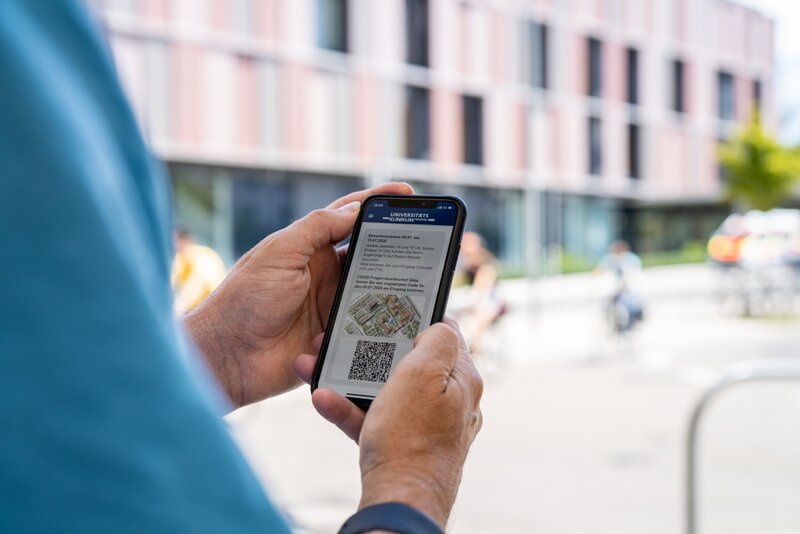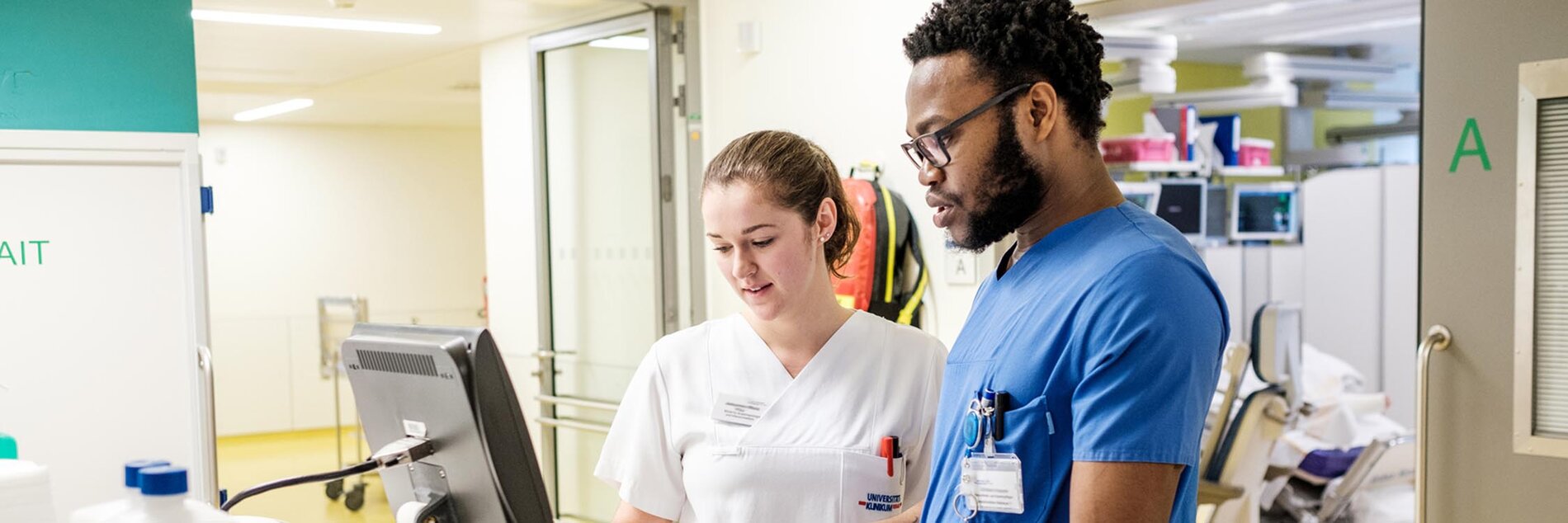Technical solutions

App for patients and visitors
In future, the University Hospital app will accompany patients before, during and after their hospital stay. It can be used to coordinate appointments, retrieve and provide documents and create visitor passes, among other things.
Get to know the app here https://www.meine-uniklinik.de/#/
Meona electronic patient file
With the Menoa electronic patient file, patients' vital signs and medication are recorded and care and treatment steps are planned and documented. This ensures paperless documentation throughout, which not only facilitates data exchange but also benefits research.
A major advantage of the electronic patient file is that it helps to avoid unwanted side effects from medication. When new medication is prescribed, the software compares it with age, body weight and possible allergies or elevated kidney values. If these contraindicate the planned active ingredients or dosages, Meona shows a red card and suggests suitable alternatives.
In a pilot project of the hospital pharmacy and the nephrology clinic, a robot packs the tablets directly in the individual dosage according to the prescription and addresses them to the respective patients.
Checkpad MED
To make coordination between doctors even more flexible, the digital patient file Checkpad MED prepares medical histories, doctor's letters, laboratory values, X-ray images and surgical reports for mobile devices such as the iPad Mini. Thanks to a secure data connection, treating physicians can also access blood values, current imaging or other important patient data outside the hospital if required. In addition, everyone involved can create tasks, track their processing status and discuss findings in secure chats. It is also possible for patients to fill out questionnaires digitally using a tablet.
Translation center - digitalization in medicine
The development of new digital solutions in the healthcare sector poses a major challenge due to the special ethical, medical and regulatory conditions. Digital health start-ups in particular, but also SMEs, often lack access to clinical routine in order to develop and test products in a protected environment in everyday clinical practice. In addition, the certification of medical devices may require a clinical study or application observations (real world data).
In this development process, the Translational Center of the University Medical Center Freiburg can be an important bridge between development and market readiness. In the sense of a living lab, it offers the opportunity to advance new technologies in a practical manner under optimal conditions so that they can benefit as many patients as possible as soon as possible.
The Living Lab
The Living Lab is located at the Neurocenter of the University Medical Center Freiburg. It has a high level of patient diversity, acute and chronic disease progression, surgical and conservative therapies and close links to referring physicians and aftercare facilities. In addition, employees are highly open to innovations, new technologies and research activities (with exemplary projects in nursing research - mobility monitoring). Employees with IT experience are available. A telematics infrastructure-compatible exchange of data outside the hospital is also being considered. This makes it possible to stay in contact with patients for prevention or aftercare as well as with pre- and post-treatment providers.
Mobile working for employees
More than 2,000 employees regularly use mobile working. This provides a fully-fledged workplace with secure access, regardless of location. Calls can be made via a softphone and employees can even be reached via their normal workstation telephone number.
Administrative processes are also continuously being converted to digital solutions. For example, it is now possible to receive monthly salary statements electronically, which many employees are already making use of.
Doctor's letter by voice recognition
Whether it's a doctor's letter or nursing documentation - there is a great need for fast, reliable documentation tools in many areas of a hospital. Previously, digitally recorded dictations had to be checked, corrected and submitted for approval by typists. With the new software, the spoken text is inserted immediately at the desired location. Corrections are rarely necessary and can be made immediately.
The system can be continuously improved by users and dictation time can be significantly reduced thanks to text modules. Cooperation with the secretariat is still necessary for use in the clinical application programs. Now that more than 1,000 users in the medical field are successfully using the system, the software is to be rolled out step by step. It is financially supported by funding from the state of Baden-Württemberg.


